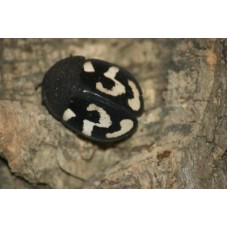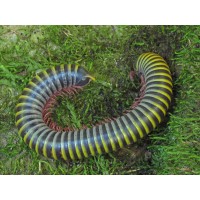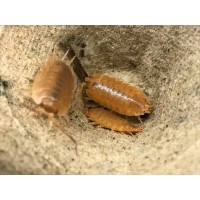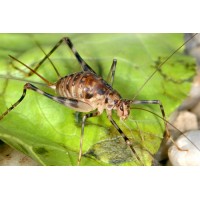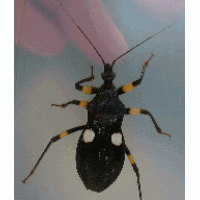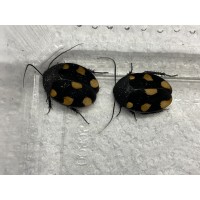Common Name : Question Mark Cockroach
Scientific Name : Therea olegrandjeani
Size : Small nymph x 6
Status : Captive Bred
This species is very similar to the Domino cockroach but the pattern on the wings look like question marks! A beautiful species of cockroach. Both sexes look alike, black with white spots, adult size approx. 2-3cm.
Food: Food : Cockroaches will eat a range of fruit, veg, cereals and kitchen scraps. I feed all my cockroaches on my dried 'cockroach mix' (muesli, cat biscuits, fish pellets and bran - mixed together), plus a little fruit and vegetables.
How I keep mine
I keep my Question Mark cockroaches in plastic boxes (24 litre or 32 litre, opaque, purchased from Wilko or Tesco). I make air holes in the lid with my little soldering iron, great for burning the right size holes through plastic. I use peat, coir or vermiculite on the base and add leaf litter (Oak, Beech or other hardwoods) and pieces of bark or egg trays to hide under. I am discovering more and more that many cockroaches will eat some leaf litter and seem to enjoy it but it isn't strictly necessary as I kept cockroaches successfully for many years without giving them any leaves. I feed them once or twice a week on my dried cockroach mix and pieces of fruit and vegetables. I find banana and cucumber are favourites.
I place my boxes on a shelf with a heat mat on it, I use a strip heat mat (15cm wide) and this covers part of the base of the box (several boxes can fit on one long mat). Like most bugs it is a good idea to give them a dry and a damp area to choose from. I find the area above the heat mat is dry and the area not covered by the heat mat is a little more moist. I use plastic boxes for my cockroaches as I have lots of species and don't have the space to keep them all in individual tanks but of course they do equally well when housed in a plastic or glass tank and are much more visible.
Some cockroaches climb better than others, I find the nymphs of the Question Mark cockroaches like to burrow but the adults prefer to be out on the surface so I wouldn’t try keeping them without a lid on the cage. Both sexes have fully formed wings and may possibly be able to fly, although I can’t recall witnessing this. They seem to like drier conditions than some other species. Most cockroaches will not do well in stale, damp conditions as this encourages mould to grow.
Question Mark Cockroach (Therea olegrandjeani) Small nymph x 6
- Product Code: 893
- Availability: 7
- £4.99
-
£3.99
Selection of Specials
Bumblebee Millipede (Anadenobolus monilicornis) Juvenile x 3
Common Name: Bumblebee Millipede Scientific Name: Anadenobolus monilicornis Size:..
£14.99
Spanish Giant Orange Isopod (Porcellio laevis) x 10 (medium/large)
Common Name: Spanish Giant Orange Isopod Scientific Name : Porcellio laevis Size : Medium/..
£4.99
Cave Crickets (Phaeophilacris bredoides) Nymphs x 3 medium
Common Name: Cave Cricket Scientific Name: Phaeophilacris bredoides Size: Nymphs x 3 m..
£4.99
White Spotted Assassin Bug (Playmeris biguttata) Adult
Common Name: White Spotted Assassin Bug Scientific Name: Platymeris biguttata Size: A..
£4.99
Orange Domino Cockroach (Therea regularis) Adult/Sub-adult (unsexed) x 3
Common Name : Orange Spotted Domino Cockroach Scientific Name : Therea regularis Size ..
£6.99
Pamphobeteus machala - Purple Starburst Birdeating Tarantula
Common Name: Purple Starburst Birdeating Tarantula Scientific Name: Pamphobeteus machala S..
£75.00




